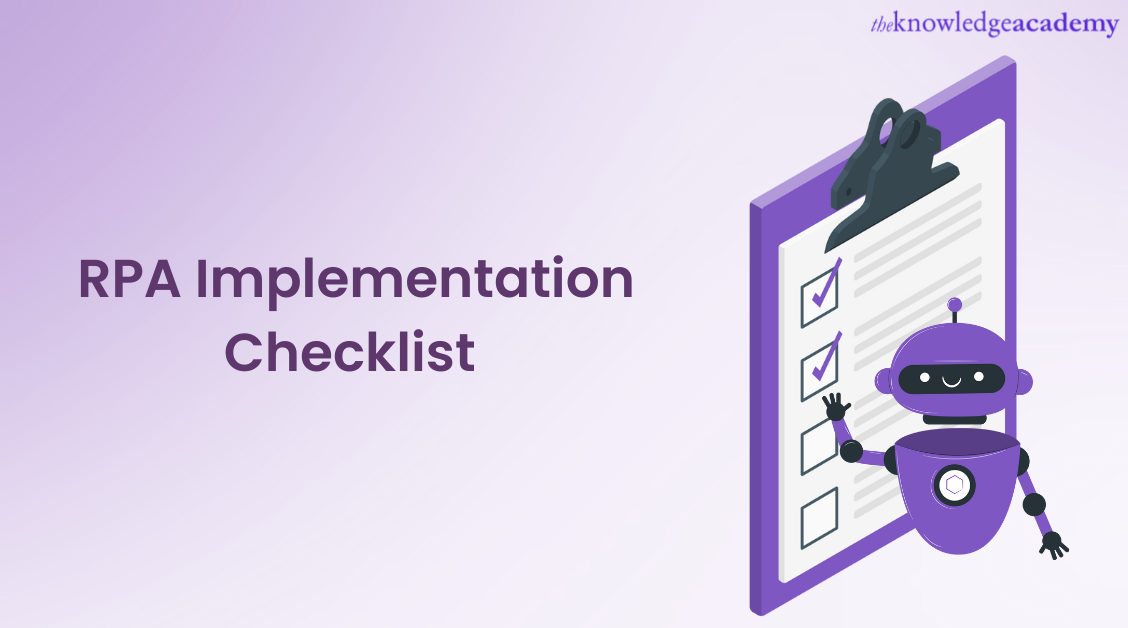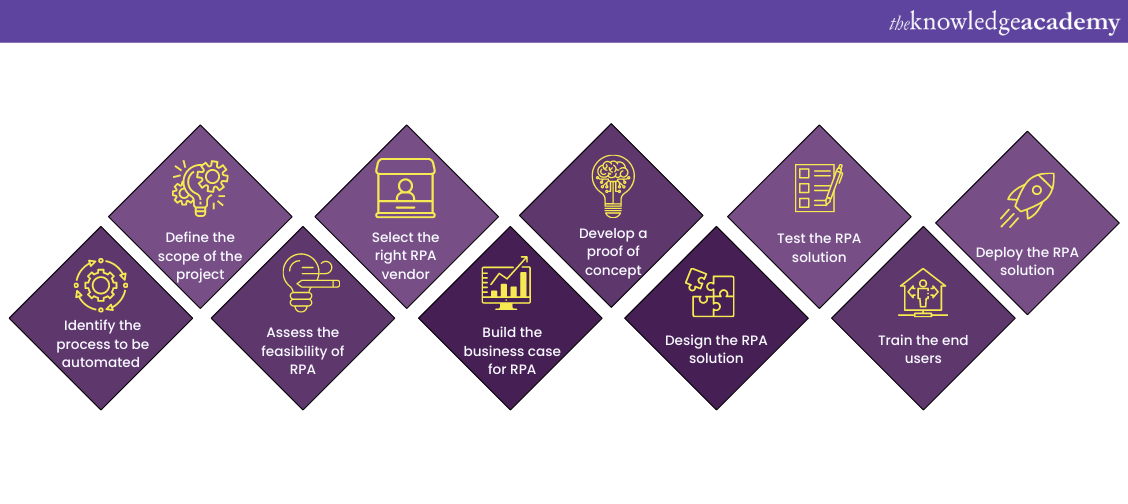We may not have the course you’re looking for. If you enquire or give us a call on 01344203999 and speak to our training experts, we may still be able to help with your training requirements.
Training Outcomes Within Your Budget!
We ensure quality, budget-alignment, and timely delivery by our expert instructors.

Robotic Process Automation (RPA) is an emerging technology. It involves using software or bots to automate repetitive, rule-based tasks, freeing time for employees to focus on more value-adding activities. As an emerging technology witnessing widespread adoption in various industries, it requires certain prerequisites in place, which is why organisations use RPA Implementation Checklists. A report by Gartner shows that companies can reduce their operational costs by over 30% by using the automation technology.
In this blog, we will explore the steps to creating a comprehensive RPA Checklist and the consequences of implementing RPA without a Checklist.
Table of Contents
1) Advantages of implementing RPA
2) Steps involved in creating RPA Implementation Checklist
a) Identify the process to be automated
b) Define the scope of the project
c) Assess the feasibility
d) Select the right vendor
e) Build the business case for RPA
f) Develop a proof of concept
g) Design the solution
h) Test the solution
i) Train the end users
j) Deploy the solution
3) Consequences of implementing RPA without a Checklist
4) Conclusion
Advantages of implementing RPA
As discussed above, RPA is a technology that automates repetitive, rule-based tasks using software bots, which can perform tasks faster, more accurately and lesser long-term cost than human workers. Below are some of the key advantages of implementing RPA:
1) Increased efficiency: RPA can automate tasks 24/7 without breaks, resulting in faster task completion time, higher output and fewer errors, leading to increased efficiency.
2) Cost savings: Bots can perform tasks at a lower long-term cost than human workers. Organisations can achieve significant cost savings regarding salaries, benefits, and other expenses incurred for human labour.
3) Improved accuracy: Bots and programs can perform tasks with a level of accuracy that cannot be expected from human labour. This reduces the risk of human errors within an organisational process.
4) Scalability: RPA can scale up or down easily and effectively to meet the changing requirements of an organisation. Adding additional bots is usually easier than hiring and training additional staff.
5) Better employee satisfaction: Bots can free employees from mundane, repetitive tasks, allowing them to focus on higher-value tasks requiring human involvement. RPA implementation could lead to better employee satisfaction.
6) Faster implementation: Implementing RPA tools is far less complex and generally faster than implementing other automation solutions, such as Enterprise Resource Planning (ERP) and additional custom software development.
7) Improved compliance: Automation software and bots can help ensure compliance with regulations and policies by automating processes that have defined these rules and procedures, reducing the risk of errors and omissions.
Steps involved in creating RPA Implementation Checklist

To successfully create an RPA Checklist, these steps are necessary:
a) Identify the process to be automated
The first step in implementing RPA is to identify the task or process that needs to be automated. This process should be a repetitive, rule-based one that has scope to be automated. It’s essential to prioritise the process based on its impact on business operations, cost-saving potential, and ease of implementation.
b) Define the scope of the project
After identifying the task to be automated, the next step is to define the scope of the RPA bot. This involves identifying the tasks that will be automated, the expected outcomes, and the timeline for Implementation. It is essential to involve all stakeholders in defining the scope of the RPA bot to ensure that everyone is aligned and there are no misunderstandings.
c) Assess the feasibility
Before implementing RPA, it is pivotal that we assess the feasibility of automation in the business process. This involves analysis of the task to be automated, identification of any probable roadblocks, and evaluate the suitability of RPA technology for the specific task. It is essential to involve technical experts in this feasibility discussion.
d) Select the right vendor
After assessing the feasibility of automation, the next step is to select the right RPA vendor. This involves evaluating different RPA vendors based on their capabilities, proven track records and experience in the field of RPA. Another point to note is that organisations are generally more inclined to select RPA vendors with expertise in their industry.
e) Build the business case for RPA
Once the vendor has been selected, the next step is to build the business case for RPA. This involves identifying the expected benefits of RPA, such as cost saving, improved operational efficiency and enhanced customer experience. It’s important to quantify these benefits and present them to the higher authorities to secure funding for the automation project.
f) Develop a proof of concept
After securing funding for the RPA Bot, the next step is to develop a satisfactory proof of concept. This involves automating a small part of the process to demonstrate the feasibility of the RPA Bot and identify any potential issues that need to beaddressed before thoroughly implementing it.
g) Design the solution
After the proof of concept has been developed, the next step is to design the RPA solution. This involves defining the process flow, designing the user interface, and identifying the data sources for the RPA software or bots. Including all stakeholders in the design phase ensures the solution meets their requirements.
h) Test the solution
After the solution has been designed, the next step in the RPA Checklist is to develop and test it. This involves programming the RPA Bots, integrating them with the existing IT infrastructure, and conducting comprehensive testing to ensure the solution functions as expected.
Eager to learn more about Robotic Process Automation, refer to our blog on "RPA testing"
i) Train the end users
After the RPA solution has been designed, developed and tested, the next step is to train the employees and end-users. This involves providing training on using and interacting with the RPA Bots involved in the business process. Providing ongoing training and support is pivotal to ensure that the employees are comfortable with the RPA Bot and can use it effectively.
j) Deploy the solution
After the end users have been trained and the stakeholders approve the proof of concept, the final step is to deploy the RPA Bot. During the initial phase of deployment, careful and methodical controlling is necessary. Further, the feedback from the deployment can be used to improve the RPA solution.
Become part of the automation revolution. Sign up for Robotic Process Automation Training now!
Consequences of implementing RPA without a Checklist
Planning for any long-term business process change without a roadmap will lead to post-implementation struggles. The same applies to RPA. Attempting to integrate a bot without an RPA Checklist leads to consequences such as:
1) Incomplete automation: Without a Checklist, there is a higher likelihood of missing critical steps in the automation process, which can lead to incomplete automation. This can result in errors, delays, and lower efficiency.
2) Inefficient use of resources: Implementation without a Checklist can result in inefficient use of resources, including time and money. The lack of a clear plan can cause unnecessary delays and require additional resources to complete the project.
3) Lack of scalability: Implementation without a Checklist may lead to the bot not being scalable, which will limit its effectiveness. If the goals and directives of the organisation change, this may lead to higher costs, lower efficiency and reduced ROI.
4) Security risks: Implementation without a Checklist can increase the risk of security breaches, such as unauthorised access to sensitive data. This can lead to legal and eventually financial consequences, including lawsuits, fines and damage to the organisation’s reputation.
5) Poor user adoption: Without a Checklist, RPA Implementation may not be user-friendly, which can lead to poor user adoption. This can result in resistance from employees and lower efficiency gains.
Conclusion
Organisations from many industries have started to adopt RPA and embark on the automation journey. Most of them find success (92% of organisations worldwide have found that RPA is essential, but the minuscule percentage that is yet to find success needs to practice having an RPA Checklist.
Following every step of the RPA Implementation Checklist above would help solve most technical and non-technical issues with automating tasks within a business process.
Understand how to deliver OpenSpan solutions and projects with OpenSpan RPA Training. Sign up now!
Frequently Asked Questions
Upcoming Business Analysis Resources Batches & Dates
Date
 Robotic Process Automation using UiPath
Robotic Process Automation using UiPath
Thu 13th Feb 2025
Thu 10th Apr 2025
Thu 12th Jun 2025
Thu 14th Aug 2025
Thu 9th Oct 2025
Thu 11th Dec 2025







 Top Rated Course
Top Rated Course





 If you wish to make any changes to your course, please
If you wish to make any changes to your course, please


